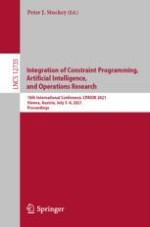2021 | Buch
Integration of Constraint Programming, Artificial Intelligence, and Operations Research
18th International Conference, CPAIOR 2021, Vienna, Austria, July 5–8, 2021, Proceedings
herausgegeben von: Peter J. Stuckey
Verlag: Springer International Publishing
Buchreihe : Lecture Notes in Computer Science
